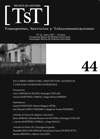Summary - TST 44
TRANSPORTES, SERVICIOS Y TELECOMUNICACIONES

Contemporary art and industrial heritage in Metropolitan Bilbao. A necessary binomial
[Download the complete article in pdf format]
<<< SUMMARY TST 44
[ Abstract ]
The metropolitan area of Bilbao, in the Basque Country (Spain),
was one of the epicentres of industrialisation in southern
Europe between the 19th and 20th centuries. After the oil crisis
in 1973 and the subsequent industrial reconversions that took
place in the 1980s, it began a decline that led to the closure
of a large part of its industrial fabric and the obsolescence of
its important rail freight network. This shipwreck of a
socio-economic system based on heavy industries caused a real
catharsis. The drift towards a new post-industrial stage meant,
in addition to a socio-economic transformation in which the
tertiary sector, led by tourism, the hotel industry and the
cultural industries, was reinforced, an urban and landscape
mutation of the first order. In order to promote a rapid
transition between eras, a massive demolition of obsolete
industrial, port and railway installations was carried out,
under the cover of a clean-cut institutional policy, without a
thoughtful process and disregarding the recommendations of the
technical experts in the field consulted. In short, there is no
institutional commitment to protect, enhance and disseminate the
rich and heterogeneous Basque industrial heritage.
It is from this research problem that the doctoral thesis
presented here was forged. The hypothesis suggested is that art
can influence a social and political change in the protection,
valuation and management of industrial and railway heritage,
making society aware of its fragility and value. On the one
hand, the real current situation of Basque industrial heritage
is analysed on the basis of the concepts: industrial
obsolescence, management, urban-landscape transformation, reuse
of heritage and revitalisation of memory. On the other hand, it
analyses 6 artistic works in which intervention is made in the
industrial and railway heritage. The thesis presented in this
article aims to contribute to revitalising collective memory, to
claim the heritage and historical value of industrial remains as
testimonies of a crucial period in Basque history, to influence
management policies and to socialise the problem of the
obsolescence of industrial heritage through art.